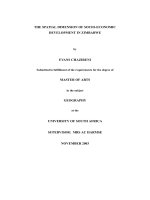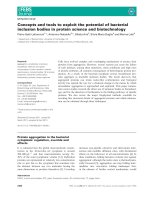ASSESSMENT THE POTENTIAL OF WIND ENERGY DEVELOPMENT IN COASTAL AREAS VIETNAM
Bạn đang xem bản rút gọn của tài liệu. Xem và tải ngay bản đầy đủ của tài liệu tại đây (936.06 KB, 31 trang )
VIETNAM NATIONAL UNIVERSITY, HANOI
VNU UNIVERSITY OF SCIENCE
FACULTY OF ENVIRONMENTAL SCIENCE
ASSESSMENT THE POTENTIAL OF WIND ENERGY
DEVELOPMENT IN COASTAL AREAS VIETNAM
Undergraduate thesis
Environmental sciences
Advanced progarm
Hanoi – 2014
ACKNOWLEDGEMENT
During the period of studying at VNU Univeristy of Science, receiving
enthusastic help from all the teachers in Faculty of Environmental Science, I
not only accqiured knowledge but also have grown up and am more mature in
life.
I sincerely thank Assoc.Prof.Dr. Nguyen Chu Hoi for his amazing
inspiration, thoughtful and dedicated guide during my thesis.
I honestly thank to all professors in Faculty of Environmental Sciences,
especially to professors from Environmental Management Department for
devoting teaching equip us the important knowledge during the study and
pratice at the university.
It is my grateful thank the support and love from my family and friends
who always understand me and cheer me up to complete the thesis.
Though having put a lot of effort on scientific reasearch, the thesis
certainly has flaws due to personal limited knowledge, the author wishes to
receive comment and feedback from teachers and friends.
Hanoi, 30th Novemeber 2014
Student
LIST OF TABLES
Table 1. Electric consumption by sectors during 2006-2010 in Vietnam
Table 2. The average wind speed in some locations in Vietnam (m/s)
Table 3. The wind average speed in some locations at 65m
Table 4. Wind energy potential distributed by area
Table 5. The potential of wind energy at 65m height in Vietnam
Table 6. The potential of wind energy at 80m height in Vietnam
LIST OF FIGURES
Figure 1. Percentages of electricity production sources in Vietnam 2012
Figure 2. Vietnam wind resource based on seasons
Figure 3. Distribution of wind resources at the ground (altitude 10m)
Figure 4. Distribution of Vietnam wind resources at altitude 30m
Figure 5. Distribution of Vietnam wind resources at altitude 65m
Figure 6. Distribution of Vietnam wind resources at altitude 80m
Figure 7. Binh Thuan province map
Figure 8. Ninh Thuan province map
CONTENTS
INTRODUCTION...........................................................................................1
Chapter 1 – OVERVIEW...............................................................................2
1.1 Needs of electricity in Vietnam.............................................................2
1.2 Status of electricity productionsources in Vietnam...............................3
1.3 Characteristics of wind regime in Vietnam coastal areas......................4
Chapter 2 – METHODOLOGY.....................................................................5
2.1 Study object...........................................................................................5
2.2 Scope of the study.................................................................................5
2.2.1 Geographical Scope.......................................................................5
2.2.2 Issue Scope.....................................................................................5
2.3 Methods of study...................................................................................5
2.3.1 Data collection...............................................................................5
2.3.2 Theorical research..........................................................................5
2.3.3 Systhesis and process information.................................................6
Chapter 3 – STUDY RESULTS AND DISUCSSION...................................7
3.1 Benefits of wind energy use..................................................................7
3.2 General assessment the potential of wind energy in Vietnam coastal
areas...................................................................................................................8
3.2.1 Based on seasons............................................................................8
3.2.2 Based on altitude............................................................................9
3.2.2.1 Distribution of wind resources at altitude 10m.......................10
3.2.2.2 Distribution of wind resources at altitude 30m.......................12
3.2.2.3 Distribution of wind resources at altitude 65m.......................14
3.2.2.4 Distribution of wind resources at altitude 80m.......................18
3.3 Hotspot areas.......................................................................................19
CONCLUSION AND RECOMMENDATIONS.........................................22
REFERENCES..............................................................................................24
APPENDIX....................................................................................................26
INTRODUCTION
After reforming and opening up, Vietnam's economy has changed
positively. The economy developed at a rapid rate, about 7% in recent years,
that led to the demand for energy in the economy increased to 12% -13%,
almost twice the GDP growth. According to the General Electric Company in
Vietnam (EVN), if the economy remains at this level of growth, Vietnam
electricity can not supply enough and have to import with expensive price.
The demand for power was and still is a hot issue. If Vietnam wants to
develop sustainable economics, the electricity must be one step ahead. What
are solutions to the energy problem? In our country, the Party and the
Government, on the one hand improve the efficient exploitation of natural
resources to serve traditional power production, on the other hand also
gradually exploit new energy sources such as solar, hydro tidal, geothermal,
and wind resources. It really is a smart solution and suitable for energy thorny
problem, a solution that humanity is applied and has achieved many
successes.
Among the direction starting from renewable energy sources, the wind
energy is particularly interested. According to the research evaluation of
World Bank, Vietnam has the largest potential exploitation of wind energy in
Southeast Asia. The exploitation of wind resources also bring long-term
benefits of economic, environmental and social. Our country with a long
coastline is to exploit the wind strength. Under the perspective of an
environmental student, expected to consider Vietnam wind potential in coastal
areas objectively, the authors selected the topic "Assessment the potential of
wind energy development in coastal areas Vietnam”.
7
CHAPTER 1. OVERVIEW
1.1
Needs of electric in Vietnam
The average growth rate of electricity production in Vietnam for 20
years now reached a very high level, 12-13% / year – is almost twice the GDP
growth rate of the economy. And according to forecasts of the General
Electric Company in Vietnam (EVN), if the growth rate of the average GDP
continues to be maintained at 7.1% / year, the demand for electricity produced
in Vietnam in 2020 will be about 200,000 GWh, in 2030 was 327,000 GWh
[7].
Concerning the consumption structure, industry continued to take the
biggest share of from 47.4 % to 52 % in total consumption in 2006 and 2010,
respectively (Table 1). Household consumption occupied the second largest
share but slightly reduced due to fast industrialization in Vietnam, from
42.9% in 2006 to 38.2% in 2010. Altogether service, agriculture and other
sectors occupied approximately 10% of electricity consumption.
Table 1. Electric consumption by sectors during 2006-2010 in Vietnam [12]
List
1
2
3
4
5
Agriculture
Industry
Services
Household
consumption
Other
2006
(%)
1.1
47.4
4.8
2007
(%)
1.0
50
4.8
2008
(%)
1.0
50.7
4.8
2009
(%)
0.9
50.6
4.6
2010
(%)
1.1
52.5
4.5
42.9
40.6
40.1
40.1
32.8
3.8
3.7
3.5
3.7
3.7
The growth rate of power consumption is far exceeding the GDP
growth rate in the same period. For example, during 1995-2005 the annual
growth rate of power consumption was over 14.9% while GDP growth rate
was only 7.2%. The highest growth of power demand was found in the
industrial sector (16.1%) then followed by the residential sector (14%).
8
In the future, according to the National Power Development Master
Plan VII, the electricity demand of the country will be continued to grow by
14 - 16% per year in the period 2011-2015 and then slow down to 11.15% per
year in the period 2016-2020 and 7.4 – 8.4% per year in 2021-2030 [14].
1.2
Status of electricity productionsources in Vietnam
It can be seen, the main source of eletricity production in Vietnam is
hydroeletricity. Vietnam currently has 75 large hydropower plants and more
than 470 works of small and medium hydropower capacity from 1000-3000
MW.
Figure 1. Percentages of electricity production sources in Vietnam 2012 [17]
According to the development planning of national electricity in 20112020, vision to 2030, Vietnam will continue to prioritize the development of
hydropower resources, bringing the total capacity of 14,000 MW from hydro
sources at present to 21,300 MW in 2020. However, this energy to sustainable
development, Vietnam must do a good job of planning, construction process
and full disclosure to the people. However, besides the benefits of renewable
energy sources is not limited in time, but operators are limited in scale mining
9
[7]. Hydropower plans affect large residential areas, loss of local ethnic
cultrure,…
Gas and thermal electric (oil, gas, coal) are the next highest proportion
in electricity production sources. But the raw materials used in electricity
production is fossil fuel. They can not provide permanent power sector
because stocks are limited. In addition, these materials cause environmental
pollution, CO2 emissions caused greenhouse effect, is a huge disadvantage.
Therefore, these electrcity production sources should not be used widely.
Vietnam has to import electricity because production is not enough
while Vietnam has a lot of potentials in renewable resources. The other part
(nuclear, wind, solar,…) takes only 0.2% in total.
1.3
Characteristics of wind regime in Vietnam coastal areas
Vietnam climate is humid tropical rain with northeast and southwest
monsoon. The coastline is long therefore amount of wind annual is relative
large with wind speed 8-10 m/s.
In Vietnam, the region where can develop wind energy is not spread
evenly over the entire territory. With the influence of the monsoon, wind
regime is different. If in northern Hai Van Pass, the main wind season
coincides with the northeast monsoon season, in which the most potential
areas of Quang Ninh (Quang Binh) and Quang Tri. In the southern part of the
Hai Van Pass, season coincides with the monsoon winds southwest, and the
most promising areas of Highland plateau, the coastal provinces of the
Mekong Delta, and especially the coastal areas of the both Binh Thuan and
Ninh Thuan [2].
CHAPTER 2. METHODOLOGY
10
2.1 Study Object
The thesis’s object is the wind energy.
2.2 Scope of the study
2.2.1 Geographical Scope
Vietnam coastal areas
2.2.2 Issue Scope
Potential of wind energy
2.3 Methods of the study
2.3.1 Data collection (Secondary sources)
This is the traditional method used in scientific research. Research on
wind energy is not really new topics, knowledge of the problem has existed
for a long time, to be constantly added and updated. There are many different
aspects to consider and evaluate the above mentioned data and information.
Therefore, methods of collecting information materials is of great importance,
the thesis would not be complete without this method.
The data and information have been collected from secondary sources
such as publications, papers in journals, preserved reports and reviews, etc.
inside and outside Vietnam.
2.3.2 Theorical research
After collecting references, the author reads and analyzes to understand
fully the contents are concerned, then selects and gathers content for each
specific research needs.
Codification is to arrange documents, information obtained relating to
the content being studied in a scientific structures with coherent. The source
material is selected according to the specific content of each system, and
presents an overview problem logically and reasonably. Especially, the
11
process of the existing data and information helped me in identification of the
inforamation and data gaps which should be fulfilled in during the study.
2.3.3 Synthesis and evaluation
This is a important research method to approach the issues from the
discrete documents, information of various sources (of research, textbooks,
internet,…). We can sort them according to the system which is suitable with
the content of the studied subject. Then, analyze and synthesize to find
common characteristics for evaluating the potential of wind energy in coastal
areas of Vietnam. The process results are the information tables, schemes, and
other figures to compare and illustrate the author’s concerns.
12
CHAPTER 3. STUDIED RESULTS AND DISCUSSION
3.1 Benefits of wind energy use
Wind energy in itself is a source of renewable energy which means it
can be produced again and again since it is available in plenty. It is cleanest
form of renewable energy and is currently used many leading developed and
developing nations to fulfill their demand for electricity.
Dependence on the fossil fuels could be reduced to much extent if it is
adopted on the much wider scale by all the countries across the globe. It could
be answer to the ever increasing demand for petroleum and gas products.
Apart from this, it can also help to curb harmful gas emissions which are the
major source of global warming.
Wind energy doesn’t pollute at all. It is that form of energy that will
exist till the time sun exists. It does not destroy the environment or release
toxic gases. Wind turbines are mostly found in coastal areas, open plain and
gaps in mountains where the wind is reliable, strong and steady. An ideal
location would have a near constant flow of non-turbulent wind throughout
the year, with a minimum likelihood of sudden powerful bursts of wind.
The cost of producing wind energy has come down steadily over the
last few years. The main cost is the installation of wind turbines. Moreover
the land used to install wind turbines can also be used for agriculture purpose.
Also, when combine with solar power, it provides cheap, reliable, steady and
great source of energy for the for developing countries like Vietnam [8,9].
Wind energy on the other hand has created many jobs for the local
people. From installation of wind turbines to maintenance of the area where
turbines are located, it has created wide range of opportunities for the people.
Since most of the wind turbines are based in coastal and hilly areas, people
living there are often seen in maintenance of wind turbines[12].
13
3.2 General assessment of the potential of wind energy in Vietnam coastal
areas
3.2.1 Based on seasons
Wind resources are affected by the monsoon in the months among
seasons and the trade wind in the intermediate relay months. Winter is the
period of the prevailing northeast monsoon starts from October to April next
year. Summer is a popular period of the summer monsoon, the main direction
is southwest on almost all the territory, while the summer winds lasted from
May to October. Wind speed in the winter is up to 8 - 10 m/s in the marine
and in coastal areas approximately 5-7 m/s [3].
In general, deeply influenced by the monsoon, wind resources of
Vietnam have differentiation in terms of the time of year. Accordingly, each
region is influenced by two different northeast monsoon and southwest. The
magnitude of the wind speed and magnitude of wind energy in every place in
every monsoon depends on the topography and geographical location of the
area.
These coastal areas have higher potential wind energy in cold weather
than hot weather clearly are the coast and coastal plains from Ha Tinh to Ca
Mau, especially from Tuy Hoa to Phan Thiet.
These coastal areas have higher potential wind energy in hot weather
than cold weather are :
- West coast and the next part of the Southern plains.
- Coast from Haiphong to Dien Chau - Nghe An and plain next to.
Distribution of wind resources based on seasons can be seen as troubles
in process of exploitation. There are some locations get priority in particular
monsoon season but the total wind energy is inadequate.
14
Figure 2. Vietnam wind resources based on seasons [14]
Note: 1. XII-II; 2. IX-XI; 3. VI-VIII; 4. III-V
3.2.2 Based on altitude
Topography and altitude control wind resources deeply, so that wind
resources from the ground, there is no uniformity when altitude changed. The
assessment of the wind resources in accordance with the scale: at the ground,
15
20m, 30m, 65m, and 80m is the index at which the wind resources has
deepened.
3.2.2.1 Distribution of wind resources at the ground (altitude 10m)
It can be seen, the wind speed in Vietnam is generally small. Most of
the territory of the annual average of wind speed does not exceed 3m/s. On
the coast of the northern plains and the terrain adjacent to the southern coast
of Quang Ninh, Thai Binh, Hai Phong, average speed of the wind is over
3m/s.On the narrow coastal strip of beach front Central, average speed of the
wind is over 2m/s. Coastal areas from Tuy Hoa to Phan Thiet have good wind
speeds, especially on the headland spreading to the sea such as caps Ca Na,
Mui Ne,...in this area wind in the cool season is dominant than the hot season.
Southerncoast has a rich wind potential. Especially the west coast from Ha
Tien to Ca Mau, which directly influenced by the southwest monsoon, during
the hot season has very high wind energy potential [3].
The figure 3 and table 2 present the distribution of wind resources at
the ground (altitude 10m) in Vietnam coasts and the average speed of the
wind (m/s) in some locations in Vietnam, respectivley.
Therefore, we can assess wind resources in terms of ground level: In
most territories have small wind energy potential, the exploitation of energy
less efficiently. Only from exploitation in the northern coastal areas of Cam
Pha to Nam Dinh, the northern plain adjacent to the coast; coastal area of Ha
Tinh and Vinh Linh, South Central Coast from Khanh Hoa back on and
southern coastal areas. However, the potential of this place is only suitable for
small capacity engines.
16
Figure 3: Distribution of wind resources at the ground (altitude 10m) [14]
17
Table 2. The average speed of the wind (m/s) in some locations in Vietnam
[15]
Location
Lai Chau
Lao Cai
Ha Noi
Co To Island
Nam Dinh
Bach Long Vi
Hon Ngu
Hoi An
Khe Sanh
Phu Quy
Average Wind
Speed (m/s)
2.9
4.2
2.0
4.2
3.8
7.1
3.9
6.0
3.0
6.5
Location
Nha Trang
Truong Sa
Ho Chi Minh City
Buon Me Thuot
Phu Quoc
Vung Tau
Pleiku
Rach Gia
Hon Dau
Quy Nhon
Average Wind
Speed (m/s)
2.8
5.9
3.8
2.3
6.2
3.1
2.8
2.3
5.0
4.9
3.2.2.2 Distribution of wind resources at altitude 30m
At this altitude,there are some suitable places for motors, wind turbines
with medium to large capacity. On land, mountains and plateaus Tay Nguyen
connected with South Central coastal strip has the most abundant potential.
Next position is the southern coast (Fig. 4).
18
Figure 4: Distribution of Vietnam wind resources at altitude 30m [16]
With the increase of altitude, at 30m above the ground, half of the
territory has potentially greater than 400KWh/m2 annual. In many coastal
areas, total wind energy potential is greater than 700KWh/m 2. Total energy
capacity is larger than 1000KWh/m2 that areappeared in the coastal provinces
19
of North Delta, Southwest coast and some parts of the coast Thuan Hai and
east coast of the South.
Thus, at this altitude, there are some suitable places for motors, wind
turbines with medium to large capacity. On land, mountains and plateaus Tay
Nguyen connected with South Central coastal strip has the most abundant
potential. Next is the southern coast.
3.2.2.3 Distribution of wind resources at altitude 65m
Table 3. The wind average speed in some locations at 65m
Area 1
1
2
3
4
Area 2
5
6
7
8
Area 3
9
10
11
12
Location
Wind average speed at
altitude 65m
Mong Cai – Quang Ninh
Van Ly – Nam Dinh
Sam Son – Thanh Hoa
Ky Anh – Ha Tinh
5.80
6.88
5.88
6.48
Quang Ninh – Quang Binh
Gio Linh – Quang Tri
Tuy Bong – Khanh Hoa
Phuong Mai – Binh Dinh
6.73
6.53
5.14
7.30
Phuoc Ninh – Ninh Thuan
Da Lat – Lam Dong
Tuy Phong – Binh Thuan
Duyen Hai – Tra Vinh
7.22
6.89
6.89
4.47
Source : EVN (2007)
It can be seen that, the locations were selected by EVN, wind resources
is abundant, wind speeds at almost locations are 5m/s. Some places have high
wind speed as Phuong Mai - Binh Dinh (7.30 m/s), Phuoc Minh City - Ninh
Thuan (7.22 m/s), Da Lat - Lam Dong (6.89 m/s ), Van Ly - Nam Dinh (6.88
m/s),... The wind speed in the South is dominant than the other areas (Fig.5).
20
Figure 5. Distribution of Vietnam wind resources at altitude 65m [16]
The table 4 shows that the wind energy potential is differently
distributed by area from Noth to South. The Central and southern parts have
technical potential of the wind energy higher than in the northern part.
21
Table 4. Wind energy potential distributed by area [14]
Area
North
Central
South
1
2
3
Technique Potential (MW)
50
880
855
Total : 1785
The table 5 presents the potential of wind energy at 65m height in
Vietnam and shows that at this altitude, many parts of the territory has high
potential. In the North, many locations have the potetial total energy use is
larger than 600KWh/m2. On the northern coast, the total energy can reach to
1300KWh/m2.
In Central, the potential total energy use is larger than 900KWh/m 2 on
narrow coastal strip from Nghe An to the provinces Quang Binh-Quang TriHue.Southern coast has a rich potential, the potential wind energy is larger
than 900KWh/m2. In many coastal location, it is larger than 1500KWh/m2.
Table 5. The potential of wind energy at 65m height in Vietnam [14]
Average
wind speed
Low
< 6 m/s
Medium
6-7 m/s
Area (km2)
Area (%)
Potential
(MW)
197.242
60.60%
100.367
30.8%
Relatively
high
7-8 m/s
25.679
7.9%
---
401.444
102.716
High
8-9 m/s
Very high
> 9 m/s
2.178
0.7%
111
> 0%
8.748
452
3.2.2.4 Distribution of wind resources at altitude 80m
At this altitude (Table 6, fig. 6), the wind energy potential in the
territory is generally very rich. In many locations, the total annual of the wind
energy is larger than 1000KWh/m2. The coastal areas have great potential,
22
especially coasts from Tuy Hoa to Phan Thiet and the coasts connect deeply
to south western plains.
Table 6. The potential of wind energy at 80m height in Vietnam [14]
Average
wind
< 4m/s 4-5 m/s 5-6 m/s 6-7 m/s 7-8 m/s 8-9 m/s > 9m/s
speed
(m/s)
Area
95916
70868
40473
2435
220
20
1
(km2)
Area
45.7
33.8
19.3
1.2
0.1
0.01
>0
(%)
Potentia
965161 708678 404732 24351
2202
200
10
l (MW)
23
Figure 6. Distribution of Vietnam wind resources at altitude 80m [16]
3.3 Hotspot areas
In Vietnam, the location can develop wind energy is not spread evenly
over the entire territory. With the influence of the monsoon, wind regime is
different.mIf in northern Hai Van Pass, the main wind season coincides with
the northeast monsoon season, in which the most potential areas are Quang
Ninh (Quang Binh) and Quang Tri. In the southern Hai Van Pass, strong wind
season coincides with southwest monsoon and the heighest potential area are
24
the coastal provinces of the Mekong Delta, and especially the coastal areas of
Binh Thuan and Ninh Thuan.
According to research by World Bank in Vietnam, there are two most
potential for developing wind energy are Son Hai (Ninh Thuan) and sand hills
at a height of 60-100m in the west Ham Tien to Mui Ne (Binh Thuan) (Fig. 7,
8).
High average speed of the wind, the amount of storms is less than the
others, wind tends to stabilize in these areas are favorable conditions for
development wind energy. During the monsoon months, the proportion of
south and southeast winds up to 98% with an average speed is 6-7 m/s that is
able to build the wind farm capacity of 3 to 3.5 MW.
Figure 7 : The wind energy potential locations in Binh Thuan province [17]
The areas has a total wind energy larger than 1000KWh/m2 corresponds
to an average wind speed of 4 m/s or more is there greater potential energy.
The energy extraction is very good and could use machines wind generators,
wind turbines with large capcacity.
25









